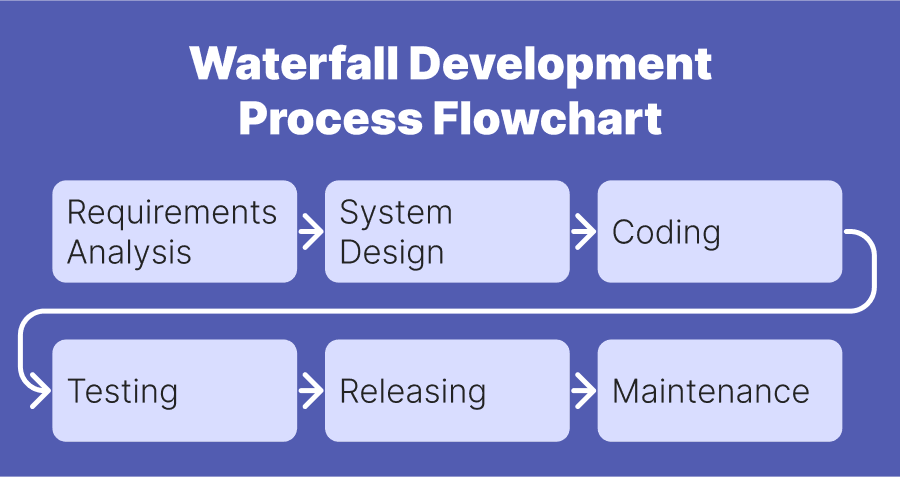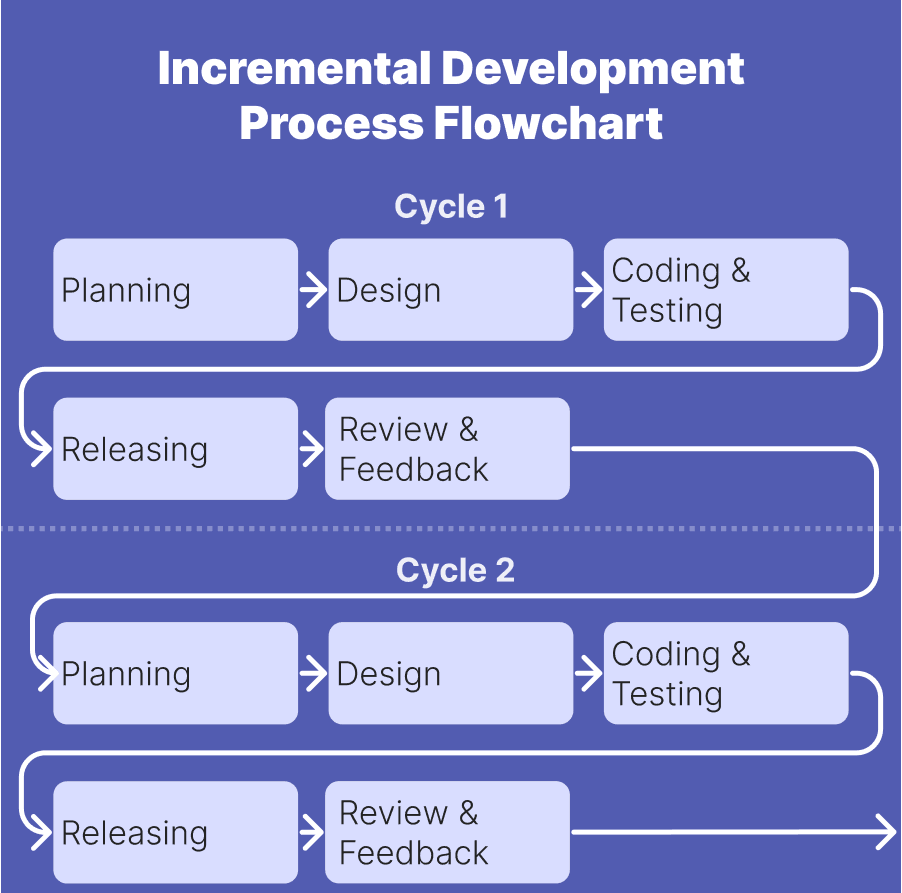Incremental vs Waterfall Model in Software Development
Topic: Tech

February 29, 2024
Let's break down the incremental development vs waterfall model differences for software development. Choosing the right approach is critical for project success.
The waterfall and incremental models are two methodologies with distinct approaches. The waterfall model is straightforward, moving from one stage to the next without revisiting previous stages. The incremental model, however, breaks the project into smaller pieces, allowing for flexibility and revisions as the project progresses.
This article will help business owners pick a model based on goals, strategy and project needs.
What Is the Difference Between the Waterfall Model and Iterative Model?
What is a Waterfall Model?
The waterfall model is a linear and sequential approach to software development.
This method is straightforward: complete one phase, then move on to the next, with no overlap between phases. It's best suited for projects with clear objectives and requirements that are unlikely to change. However, its rigidity can be a drawback in projects where flexibility and stakeholder involvement are crucial.
Incremental Model: Agile Development in Action
On the other side, we have the incremental model, a cornerstone of Agile development.
The incremental model allows the project to be divided into smaller segments, each being planned, designed, implemented, and tested as a mini-project. This approach is ideal for projects where requirements might evolve over time.
Waterfall Model vs Incremental Model at a Glance
Here's a table to compare the incremental model vs waterfall model on several critical factors:
Criteria | Waterfall Model | Incremental Model |
|---|---|---|
Process Flow | Sequential | Iterative |
Flexibility | Low; difficult to make late changes | High; easy to incorporate changes |
Risk Management | Risk of late problem detection and poor user feature acceptance | Risk of scope creep and timeline extensions |
Cost | Risk of additional costs due to late changes | Risk of additional costs due to scope creep |
Time to Market | Longer due to rigid structure | Shorter, as parts of the project can be released earlier |
Customer Involvement | Limited, primarily at the beginning | Continuous, with regular feedback loops |
Best Use Case | Projects with clear, unchanging requirements, typically of smaller scale and often intended for internal company needs | Projects with evolving requirements or the need for early releases, especially large-scale and aimed at online consumers |
Incremental vs Waterfall Process: Real-life Examples
Now, let’s delve into the specifics of the waterfall and incremental software development process, focusing on the customer's journey and participation in each.
Waterfall Process Illustrated by Warehouse Automation Tool Development

In the waterfall development of a warehouse automation app, the client's involvement is crucial only at the start. They need to provide detailed specifications, such as how to manage inventory and process orders. Once these details are set, the development team takes over, progressing through design, implementation, and testing phases with minimal client interaction.
The client then re-engages at major milestones, for example, during the first demonstration of the completed application. This approach is suitable for clients with well-defined project requirements. However, it's important to note that making changes later in the development process can be difficult and expensive, highlighting the importance of thorough initial planning.
Incremental Development Process Illustrated by Online Shop Development

In the journey of developing an online shop using the incremental model, the client kicks off the project by presenting their vision and core requirements for the initial launch - basic features like product listings, shopping carts, and user accounts. This stage sets the direction for the first cycle of development, focusing on laying the groundwork for the online store.
This sets the stage for a series of development cycles, each focusing on a specific set of features. After each cycle, the development team presents their progress, allowing the client to review, provide feedback, and request changes. This iterative approach ensures the product evolves in line with the client’s expectations and market demands, allowing for adjustments based on real user feedback.
Risks of Choosing the Wrong Model
Failing to select the appropriate model can significantly jeopardize the success of a software development project, making the decision a critical one for project managers and business owners. The selection of an unsuitable model indeed often proves to be the main cause of failures in software development projects.
In cases where the project requirements are not well-defined or are likely to change over time, choosing the rigid waterfall model can lead to significant challenges. This approach assumes that all requirements are known upfront, making it difficult to accommodate changes later in the development process. This can result in dissatisfied clients, missed deadlines, and increased costs as the team struggles to adapt to evolving needs.
Conversely, if a project with clear, stable requirements opts for the more flexible incremental model, it may experience scope creep, timeline extensions, and unnecessary complexity. The iterative nature of the incremental model can introduce additional overhead and risk if not managed effectively, leading to inefficient resource allocation and delayed delivery.
To sum up, choosing the incremental model for stable-requirement projects can lead to scope creep and increased complexity, while selecting the waterfall model might cause rigidity and inefficiency in adapting to changes.
Conclusion
To sum up, here’re key waterfall vs incremental model differences:
- The waterfall model is linear and sequential, ideal for projects with clear, unchanging requirements, offering predictability and straightforward planning.
- In contrast, the incremental model is flexible and iterative, suitable for projects with evolving needs, enabling adjustments based on feedback and market changes.
Final Recommendations on Which Model to Choose
Selecting the right model depends on balancing these factors with your project's specific needs and goals:
- Project Scope and Requirements Clarity: If your project's scope and requirements are well-defined and unlikely to change, the waterfall model may be more appropriate.
- Flexibility and Adaptability Needs: Choose the incremental model if your project needs the flexibility to adapt requirements based on ongoing feedback or market trends.
- Risk Management Preferences: For projects where minimizing risks is a priority, and early problem detection is crucial, the incremental approach offers advantages.
- Time to Market: If getting to market quickly with a core set of features is critical, consider the incremental model for its ability to release in stages.
- Customer Involvement and Feedback: Projects benefiting from continuous customer feedback and engagement are better suited to the incremental model.
For further guidance, consider consulting additional literature on software development methodologies or seeking advice from Cyfrania’s experts.
Further Reading
- Waterfall model - a Wikipedia article
- Incremental build model - a Wikipedia article
- Agile vs Waterfall, Agile vs RAD, Agile vs Exploratory Programming, Agile vs Incremental Development Models and Agile vs Spiral model Differences - a discussion on Reddit
- A Survey of Software Development Process Models in Software Engineering on ResearchGate
- Analysis and Comparison of Waterfall Model and Agile Approach in Software Projects in Academic Journal of Information Technology